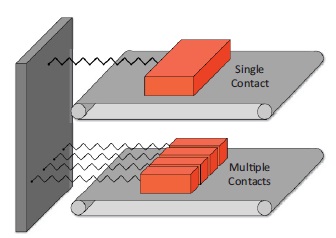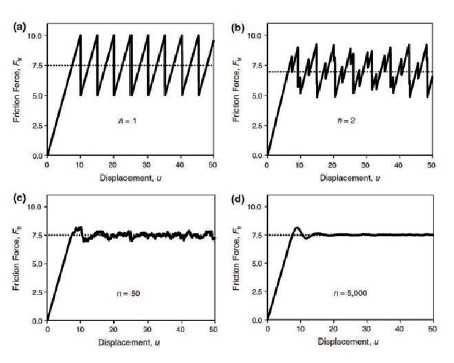Split or Squeak?
Drs. Wilfred T. Tysoe & Nicholas D. Spencer | TLT Cutting Edge April 2014
A remarkably simple model goes a long way to explaining stick-slip motion.
WE ARE ALL FAMILIAR WITH STICK-SLIP BEHAVIOR, both in our professional and our everyday lives. The sound of the violin, the squeak of the horror-movie door and the shaking during an earthquake are all manifestations of this ubiquitous phenomenon. Many studies have dealt with stick-slip, and not a few attempts have been made to model it, generally focusing on the dynamics of the slider system and the slider-track interface.
In a recent issue of Tribology Letters, Michael Varenberg and Yuri Kligerman of the Technion-IIT in Israel published an alternative, extremely simple massless (non-inertial), quasi-static (non-viscous) approach to the problem.
In systems in which the contacting area is split among many asperities, such as under the many split protuberances in the feet of certain insects and amphibians, stick-slip has been observed to be far less likely to occur than in systems where there are few but relatively large contacts.
In Varenberg and Kligerman’s model, two situations are considered (Figure 1). In the first case of “single contact,” a block attached to a fixed wall by a spring is placed on a conveyer belt and the belt set in motion. The spring force and the friction force between the block and the belt increase (stickphase) until the elastic force of the spring exceeds the static friction between the block and the belt. At this point, the block begins to slide, causing the tension in the spring to decrease until the dynamic friction value is reached so that the block sticks again and the cycle repeats.

Figure 1. Single and Multiple Contact Cases.
In the second case of “multiple contacts,” the block is divided into a number of small blocks (“subcontacts”), each being connected to the wall by a spring. This mimics the situation where contact is split between numerous asperities. This time the stiffness and friction of each sub-contact are both fractions of the values for the single-contact case, but there exists a statistical distribution of individual values for these contacts. When any particular subcontact enters the slip phase, as described above, the other sub-contacts may still be sticking or have already entered the slip-phase.
The sum of all the friction forces is shown in Figure 2 for the cases of the single (Figure 2(a)) and multiple (Figures 2 (b) to (d)) contacts, where here the contact is split into 2, 50 and 5,000 individual sub-contacts (referred to as n in the Figure). It can be seen that while the friction force displays the characteristic stick-slip behavior for the single contact, even splitting it into two contacts begins to complicate this simple behavior due to the incoherence of the two slipping blocks. When n reaches 50 or 5,000 sub-contacts, the stick-slip behavior is hardly detectable anymore, even though the total friction and spring force are the same as in the single-contact case.

Figure 2. Effect on friction behavior of splitting contact into n subcontacts (reproduced from the reference below with kind permission from Springer Science Business Media B.V.)
Such a simple model cannot reproduce all the properties of a real system, but it does go a long way toward explaining why stick-slip behavior disappears in the case of contact splitting. It also helps us to understand the materials’ influence on stick-slip and why, for instance, metals, with their many characteristic asperities, are less likely to produce stick-slip than rubber-like materials, which conform better to the countersurface, and therefore form far fewer contacts.
FOR FURTHER READING:
Kligerman, Y. and Varenberg, M. (2014), “Elimination of Stick-Slip Motion in Sliding of Split or Rough Surface,” Tribology Letters, 53(2), pp. 395-399.
 Eddy Tysoe is a Distinguished Professor of Physical Chemistry at the University of Wisconsin-Milwaukee. You can reach him at wtt@uwm.edu
Eddy Tysoe is a Distinguished Professor of Physical Chemistry at the University of Wisconsin-Milwaukee. You can reach him at wtt@uwm.edu.
 Nic Spencer is professor of surface science and technology at the ETH Zurich, Switzerland. Both serve as editors-in-chief of STLE-affiliated Tribology Letters journal. You can reach him at nspencer@ethz.ch
Nic Spencer is professor of surface science and technology at the ETH Zurich, Switzerland. Both serve as editors-in-chief of STLE-affiliated Tribology Letters journal. You can reach him at nspencer@ethz.ch.